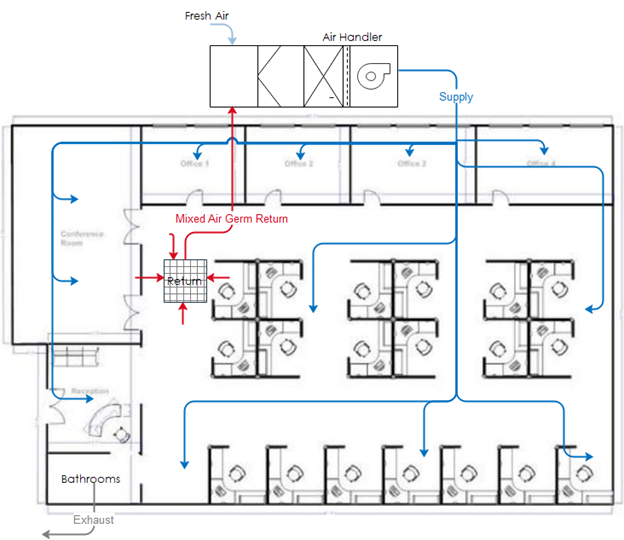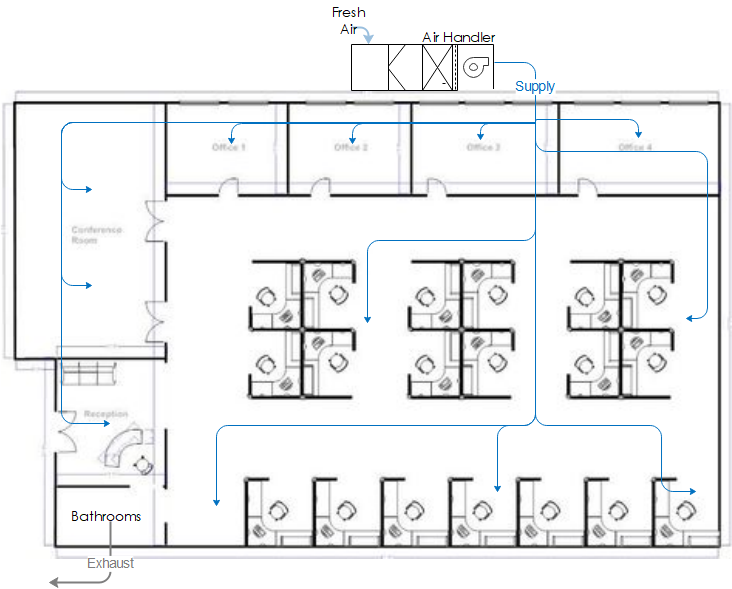
Based on my victims’ feedback, I am an above-average cook, but my internal modesty says, barely. To achieve such mediocrity, all you must do is follow the instructions and pay little attention. The next step to greatness, I’ve heard, is to weigh rather than measure things (cups, teaspoons, etc.). No. Thanks. Beyond that probably requires the Malcolm-Gladwell 10,000 hours to achieve excellence as a professional.
Designing and constructing buildings is a lot like cooking, and I think most “efficient” buildings are in my categorical class of cooks: mediocre-plus. Unlike great amateur cooks, designers and builders need to be paid for their time, attention to detail, and even crews focused on a great job for efficiency. Big gains in efficiency can be achieved by avoiding certain equipment and system designs that suck. I.e., we develop requirements that are simple, like meal kits that bring everything to your door, pre-measured, and all you need to do is add heat and use a clock.
The Blueprint
I ranted about this topic many times and wrote and presented a paper on this long ago at the ACEEE Summer Study for Buildings. The paper was used as a reference for similar studies conducted by universities. Since then, nothing has changed, except energy codes became grotesquely more complex to accommodate every dumb design ever invented and kept alive rather than rightfully killed over the past century.
Here is my simple idea: You want to build those large complex systems that require a full-time watchdog to keep in check, go ahead, but they will not be part of an efficiency program. Consider them to be like light trucks: if you want to buy a Ford F150, go ahead, but it won’t be allowed in the efficiency program.
We need to get real, folks. Equity doesn’t apply to efficiency. Not every system type has rights to the program. Applicants must design and build to the program specifications – all of them – or they are out. Some designers and builders will whine and complain because their rubber stamp no longer qualifies.
So what design elements are required? Refer to the ACEEE paper, but I’ll summarize them here.
Lighting and Envelope
Lighting is barely worth mentioning since LED technology has achieved market dominance. However, features like daylighting and task lighting are great things to save energy and provide a visually comforting occupied space.
As for glazing (windows), I learned that tunable properties are becoming cost-effective, especially for specific HVAC-related needs. I will need to study that further for another day. For now, east and west-facing windows should be minimized, although that is not always possible due to the configuration of some lots. If east and west glazing is necessary, it should have low solar heat gain coefficients – which is to say; they let very little solar energy through. Minimizing solar gains avoids uneven heating and cooling loads from one side to the other, which is often a major cause of waste.
The All-Important HVAC
First, dedicated outdoor air systems (DOAS) are REQUIRED! No exceptions. These systems move fresh air through the building one time and out. Germophobes rejoice because this eliminates the possibility of air from an entire building or floor being recirculated into your pristine environment. If energy alone doesn’t get peoples’ attention, maybe they will wake up if I tell them truthfully that a DOAS greatly reduces the spread of coronavirus. Refer to one of the non-energy benefits of COVID for brilliant details.
See the cartoon below and follow the arrows. Centrally-supplied air heats and cools spaces. Substantial airflow is required to keep rooms within temperature ranges and to require air and germ recirculation. A small fraction of the supply air is exhausted through bathrooms or kitchens, and the rest is returned from every space occupied by coughing, wheezing, and sneezing occupants.
Now for the DOAS system, shrink all the air supply lines by 75% and eliminate the coughing, wheezing, and sneezing return air. All air is moved once through the air handler and out through the bathrooms.
Another benefit of DOAS is excellent humidity control. Outdoor air is often the most significant contributor of moisture in building air. The DOAS approach allows outdoor air to be cooled to 45F to wring extra moisture out of the air without the need for heating it to maintain comfortable temperatures. This keeps relative humidity in the 50% range, even in crowded spaces. More people require more ventilation and more dry air. Once through and out.
For the greatest savings and least spread of pathogens with DOAS, use radiant heating and cooling. In this case, not only are occupants not breathing everyone else’s air in the building, they don’t even have to share air with folks in the room. Furthermore, fan power is almost eliminated.
Finally, DOAS avoids the impossible task of controlling ventilation volumes with archaic, yet still allowed by code, central HVAC systems. In those cases, you have certain percentages of “unused” air coming back from every zone (room) in the building, mixed and returned. The math behind the algorithm to manage ventilation to each room is obscene, and the sensor cost to feed the algorithm is scandalous.
Finally, heat recovery should be required to move heat from spaces needing cooling all year to spaces needing heat much of the year. In the cartoon above, that would be from the middle of the building to the perimeter much of the winter and some of the shoulder seasons. Heat recovery can be accomplished with:
- Heat recovery chillers
- Multi-zoned heat pump systems (variable refrigerant flow), and
- Water-loop heat pump systems (e.g., “geothermal” or ground-source)
Keeping programs simple and focused can actually remove barriers to participation accelerating good building design and energy savings. Let’s get cooking on simpler solutions.






